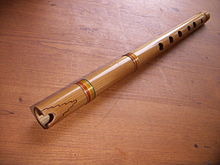The clarinet is a single-reed musical instrument in the woodwind family, with a nearly cylindrical bore and a flared bell.

The flute is a member of a family of musical instruments in the woodwind group. Like all woodwinds, flutes are aerophones, producing sound with a vibrating column of air. Unlike woodwind instruments with reeds, a flute produces sound when the player's air flows across an opening. In the Hornbostel–Sachs classification system, flutes are edge-blown aerophones. A musician who plays the flute is called a flautist or flutist.
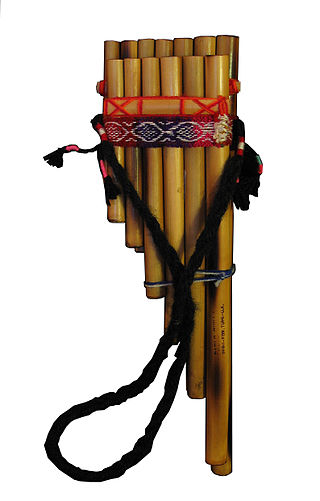
A pan flute is a musical instrument based on the principle of the closed tube, consisting of multiple pipes of gradually increasing length. Multiple varieties of pan flutes have been popular as folk instruments. The pipes are typically made from bamboo, giant cane, or local reeds. Other materials include wood, plastic, metal and ivory.

The recorder is a family of woodwind musical instruments in the group known as internal duct flutes: flutes with a whistle mouthpiece, also known as fipple flutes. A recorder can be distinguished from other duct flutes by the presence of a thumb-hole for the upper hand and seven finger-holes: three for the upper hand and four for the lower. It is the most prominent duct flute in the western classical tradition.

The tin whistle, also called the penny whistle, is a simple six-holed woodwind instrument. It is a type of fipple flute, putting it in the same class as the recorder, Native American flute, and other woodwind instruments that meet such criteria. A tin whistle player is called a whistler. The tin whistle is closely associated with Irish traditional music and Celtic music. Other names for the instrument are the flageolet, English flageolet, Scottish penny whistle, tin flageolet, or Irish whistle.

A shakuhachi is a Japanese longitudinal, end-blown flute that is made of bamboo. The bamboo end-blown flute now known as the shakuhachi was developed in Japan in the 16th century and is called the fuke shakuhachi (普化尺八). A bamboo flute known as the kodai shakuhachi or gagaku shakuhachi (雅楽尺八) was derived from the Chinese xiao in the Nara period and died out in the 10th century. After a long blank period, the hitoyogiri shakuhachi (一節切尺八) appeared in the 15th century, and then in the 16th century, the fuke shakuhachi was developed in Japan. The fuke shakuhachi flourished in the 18th century during the Edo period, and eventually the hitoyogiri shakuhachi also died out. The fuke shakuhachi developed in Japan is longer and thicker than the kodai shakuhachi and has one finger hole less. It is longer and thicker than hitoyogiri shakuhachi and is superior in volume, range, scale and tone quality. Today, since the shakuhachi generally refers only to fuke shakuhachi, the theory that the shakuhachi is an instrument unique to Japan is widely accepted.

Andean music is a group of styles of music from the Andes region in South America.

The kaval is a chromatic end-blown oblique flute traditionally played throughout the Balkans and Anatolia. The kaval is primarily associated with mountain shepherds.

Scaling is the ratio of an organ pipe's diameter to its length. The scaling of a pipe is a major influence on its timbre. Reed pipes are scaled according to different formulas than for flue pipes. In general, the larger the diameter of a given pipe at a given pitch, the fuller and more fundamental the sound becomes.
The Western concert flute is a family of transverse (side-blown) woodwind instruments made of metal or wood. It is the most common variant of the flute. A musician who plays the flute is called a “flautist” in British English, a “flutist” in American English.
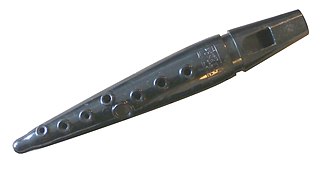
The stub-ended Swanson tonette is a small, end-blown vessel flute made of plastic, which was once popular in American elementary music education. Though the tonette has been superseded by the recorder in many areas, plastic Tonettes are still in use in elementary schools around the nation due to their price, durability, and simplicity. The range of the tonette is from C4 to D5. A skilled player can produce notes above the principal register by overblowing and half-covering holes. Similar instruments are the song flute, flutophone, and precorder.

An organ pipe is a sound-producing element of the pipe organ that resonates at a specific pitch when pressurized air is driven through it. Each pipe is tuned to a note of the musical scale. A set of organ pipes of similar timbre comprising the complete scale is known as a rank; one or more ranks constitutes a stop.
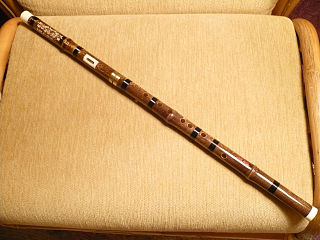
The bawu is a Chinese wind instrument. Although shaped like a flute, it is actually a free reed instrument, with a single metal reed. It is played in a transverse (horizontal) manner. It has a pure, clarinet-like timbre and its playing technique incorporates the use of much ornamentation, particularly bending tones.

The fujara is a large wind instrument of the tabor pipe class. It originated in central Slovakia as a sophisticated folk shepherd's overtone fipple flute of unique design in the contrabass range.

A tone hole is an opening in the body of a wind instrument which, when alternately closed and opened, changes the pitch of the sound produced. Tone holes may serve specific purposes, such as a trill hole or register hole. A tone hole is, "in wind instruments[,] a hole that may be stopped by the finger, or a key, to change the pitch of the tone produced."

In music, the bore of a wind instrument is its interior chamber. This defines a flow path through which air travels, which is set into vibration to produce sounds. The shape of the bore has a strong influence on the instrument's timbre.
The shvi is an Armenian fipple flute with a labium mouth piece. Commonly made of wood or bamboo and up to 12 inches (300 mm) in length, it typically has a range of an octave and a-half. The tav shvi is made from apricot wood, it is up to 18 inches (460 mm) long, and is tuned 1/4 lower producing a more lyrical and intimate sound.
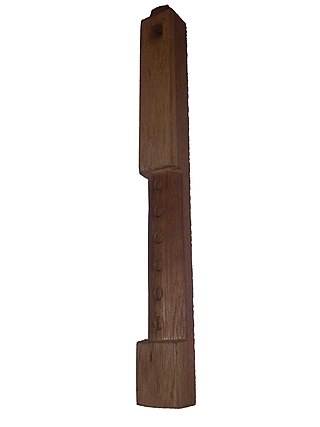
The tarka is an indigenous flute of the Andes. Usually made of wood, it has 6 finger holes, fipple on mouth end and free hole on distant end.

A wind instrument is a musical instrument that contains some type of resonator in which a column of air is set into vibration by the player blowing into a mouthpiece set at or near the end of the resonator. The pitch of the vibration is determined by the length of the tube and by manual modifications of the effective length of the vibrating column of air. In the case of some wind instruments, sound is produced by blowing through a reed; others require buzzing into a metal mouthpiece, while yet others require the player to blow into a hole at an edge, which splits the air column and creates the sound.
